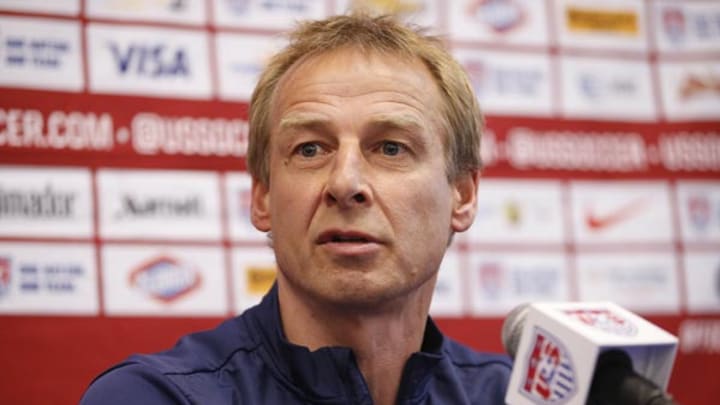As U.S. World Cup camp begins, Jurgen Klinsmann has some tough decisions to make

Jurgen Klinsmann will need to cut-down his 30-man roster to 23 before June 2nd. (Tony Avelar/AP)

STANFORD, Calif. — The calendar may say the World Cup starts on June 12 in São Paulo, Brazil, but the U.S.’s World Cup effectively began on Wednesday here with the first training session at an immaculate (and 92-degree hot) Stanford University.
Why are we here when there isn’t even a friendly game until May 27? Well, the opening days of a long national team camp are often the most useful ones for media: The players are excited not just to see each other but to talk to the press in a way that won’t quite be the same once we’re on Day 19.
On Day 1, everything is new. Anything seems possible.
For the 30 players vying for 23 spots in Brazil, the coming days will be exhilarating and punishing, filled with lung-busting fitness work, Darwinian internal competition and two-a-day practices in 90-degree heat. (The team will not usually go back to its hotel between training sessions.) On June 2 or a bit earlier, this first phase will culminate in seven final cuts -- what for many of these players will be the most stressful day of their careers.
WORLD CUP ROSTERS: A running tally of every team in the tournament
Those internal battles are the ones that stand out the most heading into the next 19 days before coach Jurgen Klinsmann and his staff make their seven cuts. Some countries, like Mexico and Brazil, have already cut down to their 23-man squads for the World Cup. Others, like the U.S., Italy and Germany, have announced 30-man rosters, which don’t have to be cut down to 23 until FIFA’s deadline on June 2.
There are two schools of thought: former U.S. World Cup defender Jimmy Conrad (who’s now with KICK TV) tweeted that bringing in 30 players would turn this camp into an unnecessary “reality show” with everyone knowing seven players are going to be voted off the island. (Klinsmann has had three years to see these guys, Conrad noted.)
But bringing in 30 gives Klinsmann flexibility and choices -- to say nothing of the ability to judge who’s in form and who isn’t -- and it’s of a piece with the main achievement of his tenure: Creating more internal competition at every position on the field. At this point, Klinsmann just doesn’t know who his 23 will be.
“When I coached in Germany in 2006, I named 23 [not 30] because I was pretty sure about the 23, so we went straightforward with that decision, and it worked out because nobody got injured,” Klinsmann said here Wednesday.
The full UMSNT 30-man roster | Notable snubs
“The reason why we took 30 [for this U.S. camp] is because we aren’t sure yet, simple as that,” he continued. “We want to see them come in and compete for the spots. We have 50-50 cases all over the place going on, so the best thing for us coaches is to look at first-hand, see them in training, see where they are right now, and then make the decision three weeks down the road.”
The players don’t have any control over how many guys Klinsmann decided to bring into camp, of course, but they did have opinions when I asked them if they’d prefer there being 23 or 30 here right now.
“Ah, final 23!” said left back DaMarcus Beasley with a laugh, perhaps because he’s been on three World Cup teams already. “Obviously, he still has some decisions to make. He’s going to take his time and make sure he picks the right 23 players. Not always the best 23 players make it. It depends on how they are in the locker room, how they are off the field with the team, with the media. It all goes into account when you’re playing a World Cup. When we’re there in Brazil, you can’t have any bad apples.”
For midfielder Brad Davis, who’s on the edge of the 23-man bubble, it doesn’t matter that much whether Klinsmann brought in 23 or 30. “I think he really wants to see who’s going to sacrifice, who’s going to push themselves to the limits, who’s going to do whatever it takes,” Davis said. “Because that’s what you need when you get to a World Cup.”
GOOGLE HANGOUT: Wahl, Straus discuss World Cup
Does the cut-throat nature of this camp mean we might see a couple bust-ups on the training field? Maybe. Does it mean there might be an injury or two? Perhaps. But Klinsmann is banking on the heightened competition helping to prepare his team for the rigors of Brazil. He also made a point of choosing players who, in Klinsmann-speak, are not “takers” but “givers” -- guys who should be good for camaraderie even if they don’t start. It wasn’t a coincidence that Klinsmann never used the term “giver” to describe Eddie Johnson, who was left off this roster despite scoring some big goals in qualifying. (Didier Deschamps left Samir Nasri off the French squad for the same reason.)
Beyond the fight to make the World Cup roster, of course, is the battle to make the starting lineup, and here, too, much is up in the air. By my count there are six players who are locks to start if healthy: Goalkeeper Tim Howard; defenders Matt Besler and Fabian Johnson; midfielders Michael Bradley and Jermaine Jones; and forward (and captain) Clint Dempsey. That leaves five starting spots up for grabs -- and at least as many open spots on the 23-man roster.
In other words, get ready for the sparks to fly here the next two weeks.
